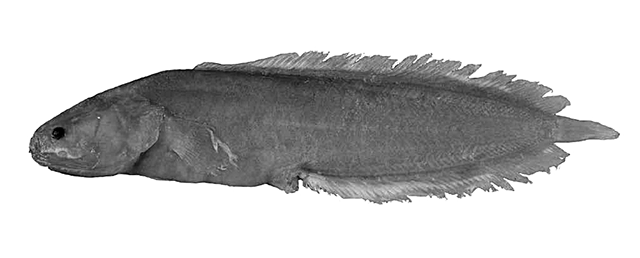| Dinematichthyidae (Viviparous brotula) |
| 4.4 cm SL (male/unsexed); 5.1 cm SL (female) |
|
benthopelagic; marine; depth range 0 - 11 m |
| Western Indian Ocean: Seychelles, Cargados Carajos, Mauritius and Reunion, except Agalega Islands. |
|
Dorsal soft rays (total): 62-73; Anal soft rays: 46-56; Vertebrae: 39-42. This species is distinguished by the following characters: D 62-73, A 46-56, pectoral fin rays 16-18, D/A 17-25, V in D 1.8-2.1; vertebrae 11+28-30 (rarely 31) = 39-41 (rarely 42); anterior nostril located 1/4-1/5 the distance from upper lip to aggregate distance to anterior margin of eye; moderately large eyes, 1.5-2.7 % SL; 2 pairs of free pseudoclaspers, outer pseudoclasper simple, flap-shaped with pointed tip, broad at base, short, slightly longer than inner pseudoclasper, the inner one is broad, with 3 ridges in anterior, posterior and inward direction and hidden in pocket of wide isthmus (in resting position); 5-7 scale rows on cheek at the upper part and 3-4 rows on lower part; presence of upper preopercular pore present; otolith very elongate, its length to height 2.3-2.5, with sulcus slightly inclined (5°) and colliculi separated, ostium length to cauda length is 3.5-4.5 (Ref. 76869). |
| Usually observed in catches from the back reef lagoonal and tide pool environments and rare to nearly absent from the main and outer reef environments where Dinematichthys indicus is found (Ref. 76869). |
|
Least Concern (LC); Date assessed: 16 August 2019 Ref. (130435)
|
|
Source and more info: www.fishbase.org. For personal, classroom, and other internal use only. Not for publication.

